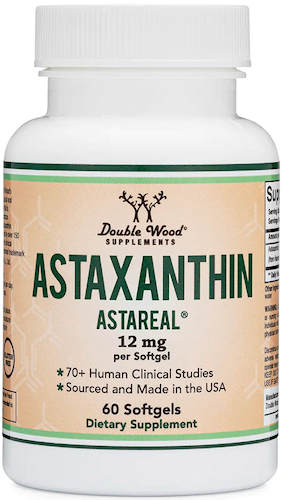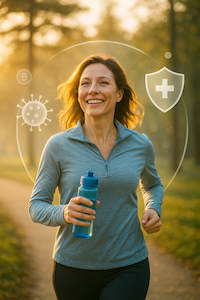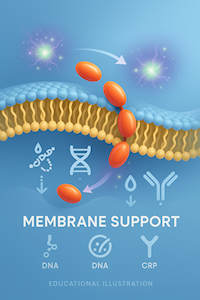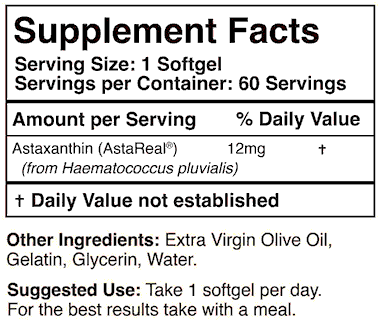
Astaxanthin — Nature’s Marine Antioxidant
What Astaxanthin Is & Why It’s Popular:
Astaxanthin is a deep-orange carotenoid (pigment) from Haematococcus pluvialis microalgae. It is lipid-soluble (fat soluble and water soluble) and is absorbed well into cell membranes. It is one of the most powerful antioxidants yet discovered.
- Exceptional membrane antioxidant: strong singlet-oxygen quenching (6,000 times more than Vitamin C) in lab assays, complementing water-phase vitamin C.
- Spans both sides of lipid bilayers—think “seatbelt for cell membranes”—protecting them from disruptive oxidative events.
- Real-world focus: people use it for screen comfort, sun-exposed days, & smoother post-workout recovery.
- Associated with longevity increases of more than 10% in laboratory animals.
Why Astaxanthin is Considered to be The Most Powerful of All Antioxidants
Among natural antioxidants, astaxanthin plays in a league of its own. First, its architecture is different. Unlike water-soluble antioxidants that float past membranes, astaxanthin’s long polyene spine and polar “anchors” let it span the lipid bilayer like a safety belt, protecting both sides of cell membranes exactly where oxidation loves to start. It doesn’t just hover nearby; it parks on the front line.
Second, its reactivity profile is exceptional. In comparative lab models, astaxanthin is a formidable quencher of singlet oxygen and lipid peroxyl radicals, the troublemakers that kick off chain reactions in skin, eyes, muscles, and vessel walls. Crucially, it’s remarkably stable under oxidative load and is far less prone to flipping into a pro-oxidant the way some antioxidants can in harsh conditions. That means more “shield” and less risk of the shield turning into shrapnel.
Third, it’s bio-compatible with the places you care about most. Being lipid-soluble, astaxanthin integrates into mitochondrial and cell membranes, associates with lipoproteins (your body’s transport for fats), and shows up in tissues that see light and oxygen—like skin and eyes. Human trials reflect this positioning: participants often report more comfortable screen time, better skin photoprotection and elasticity under UV stress, and smoother post-exercise recovery alongside favorable shifts in oxidative-stress markers.
Add in synergy—astaxanthin supports and is supported by membrane antioxidants such as vitamin E and diet-borne polyphenols—and you have a daily nutrient that doesn’t just mop up; it helps prevent the spill where it happens. No single compound can do everything, but if your goal is to fortify the body’s vulnerable membranes against modern stressors, astaxanthin makes a compelling case as nature’s most powerful membrane guardian.
Astaxanthin Ingredient & Source
Natural Astaxanthin (Haematococcus pluvialis)
Derived from microalgae and standardized for natural astaxanthin content. Lipid-soluble for membrane affinity; typically taken with meals containing healthy fats.
Formula Base & Manufacturing
Derived from microalgae and standardized for natural astaxanthin content. The AstraReal® offers superb quality, using indoor bioreactors, supercritical CO₂ extractions and is the most clinically studied and is U.S. grown/processed.
Where People Notice Astaxanthin

Exercise Recovery & Performance
Athletes, hikers, and busy “weekend warriors” often add astaxanthin for the way it supports post-workout comfort, day-to-day training consistency, and feeling a bit more “fresh” when workloads stack up. As a lipid-soluble carotenoid that sits in cell and mitochondrial membranes, it helps defend those lipid surfaces from exercise-related oxidative stress and singlet-oxygen—right where the action is. Educationally speaking, human trials have explored endurance outputs, muscle performance indices, and recovery biomarkers when astaxanthin is paired with regular training.
- What people tend to notice: steadier effort on repeat days, less next-day “drag,” and quicker bounce-back after long sessions or hills.
- Study pattern: many trials run 12 mg/day for 4–12 weeks, alongside a structured program. Effects are typically modest but meaningful when stacked with good training habits.
- How to use around workouts: take your daily amount with a meal that includes healthy fats; some athletes time it with the main meal nearest training. Split dosing (AM/PM) is optional.
- Smart stacks: pair with protein (muscle repair), electrolytes/hydration (especially in heat), omega-3s, colorful produce, and adequate sleep. These cover different parts of the recovery picture.
- Who benefits most: outdoor & high-UV training, back-to-back training days, masters athletes, and anyone rebuilding consistency after time off.
- What it will not do: it is not a stimulant and will not mask injury, poor sleep, or under-fueling—think of it as membrane support, not a shortcut.
- Quick trial plan: run 8 weeks at 12 mg/day, log RPE, set splits, and next-day soreness (0–10). Keep if your trends improve.
See the Studies & Videos section below for human research examples and longer reviews.

Oxidative Stress & Inflammation Markers
Astaxanthin sits where oxidation often begins—inside lipid membranes. As a membrane-friendly singlet-oxygen quencher, it helps defend those surfaces while training, during long screen days, and under sun or seasonal stress. In human randomized trials, researchers have tracked shifts in everyday biomarkers of oxidation & inflammatory tone when astaxanthin is added to normal habits.
- Lipid peroxidation: several studies report downward trends in markers such as TBARS/MDA or F2-isoprostanes—signals that the “rust” on lipids is calmer when astaxanthin is onboard.
- DNA oxidative damage: trials have shown reductions in 8-OHdG (a common DNA oxidation marker), consistent with less oxidative pressure on nuclei & mitochondria.
- Inflammatory tone: modest improvements are sometimes seen in hs-CRP and selected cytokines (e.g., IL-6, TNF-α) alongside antioxidant changes. Effects vary by baseline status, dose, and duration.
- Antioxidant systems: some studies note shifts in endogenous defenses (e.g., SOD, catalase, GSH:GSSG balance), suggesting support for the body’s own cleanup crews rather than a simple “mop up” effect.
- Where this matters day-to-day: skin surface lipids under UV, eye tissues during long VDT work, exercising muscle, and circulating lipoproteins—all places where membranes meet oxygen & light.
- Typical study pattern: 12 mg/day for 4–12 weeks, taken with a meal that includes healthy fats. Benefits are incremental and work best alongside sleep, protein-rich nutrition, and movement.
- What not to expect: this isn’t a drug or a stimulant. Think “membrane support that nudges markers in the right direction,” not an instant fix.
See the Studies & Videos section for human examples (lipid peroxidation, 8-OHdG, hs-CRP, and related endpoints). Educational only; individual responses vary.

Skin Hydration, Elasticity & Photoaging
Astaxanthin is a lipid-friendly carotenoid that settles into skin’s membranes and surface lipids—places where light, dry air, and everyday stress first land. Educationally, human trials (oral and topical) have reported changes in skin hydration, elasticity/firmness, and photoaging-related measures after several weeks of use.
How People Use It (Educational)
- Typical amounts: many trials use 12 mg/day for 4–12 weeks. Take with a meal that includes healthy fats.
- Smart stacks: omega-3s (membrane fluidity), vitamin E (lipid-phase partner), vitamin C/polyphenols (water-phase partners), collagen/gelatin, and steady hydration.
- Sun-sensible habits: pair with shade, hats, UPF clothing & broad-spectrum sunscreen; astaxanthin is not a substitute for sunscreen.
- Simple trial plan: run 8 weeks; track cheek hydration (touch/feel), texture, morning “glow,” and end-of-day dryness.
What the Research Says (At a Glance)
- Oral and topical trials report improvements in elasticity/hydration.
- A meta-analysis summarizes outcomes across multiple human studies, generally favoring modest but meaningful cosmetic benefits with consistent use.
Educational only; not medical claims. Individual responses vary. Best results come with sleep, nutrition, hydration, and sun-smart routines.

Healthy Aging & Cellular Protection
Astaxanthin is a membrane-friendly carotenoid that lives where everyday wear often begins—the lipid bilayers of cell & mitochondrial membranes. By nesting across those layers, it helps keep the “redox climate” calmer in places that meet light, oxygen, and mechanical stress (skin, eyes, vessels, working muscle). Think of it as support for the structures that make youthful function feel…well, youthful.
- Membrane integrity & fluidity: supports a smoother lipid environment so proteins, receptors, and channels can do their jobs efficiently.
- Mitochondrial resilience: sits in energy-making membranes, helping buffer the oxidative spillover that naturally rises with age, training, travel, or poor sleep.
- Lipoproteins & vessels: educational studies track calmer oxidation of circulating lipids and small shifts in endothelial markers—signals tied to everyday vascular comfort.
- Skin “youth cues”: human trials (oral/topical) report changes in hydration, elasticity/firmness, tone, and photo-stress endpoints—useful where sun, wind, or HVAC dry the surface.
- Eyes & visual comfort: screen-heavy days spotlight astaxanthin’s role in accommodation and perceived eye fatigue, aligning with the needs of modern work.
- Cognition & vigor (emerging): small trials explore attention, mental fatigue, and selected reproductive endpoints; evidence is mixed & still building.
- Inflammatory tone (“inflammaging”): some studies note modest shifts in everyday markers (e.g., hs-CRP) alongside antioxidant changes.
- Stacks that make sense: vitamin E (lipid phase), vitamin C/polyphenols (water phase), omega-3s (membrane fluidity), collagen/gelatin (skin support), plus sleep, protein, movement, hydration.
- Who tends to notice most: outdoor workers, frequent flyers/shift workers, masters athletes, and anyone juggling bright light, heat/cold, or lots of screen exposure.
- What it is not: not a stimulant or a drug; expect steady nudges in “how things feel,” not overnight transformations.
Astaxanthin


How to Use Astaxanthin
General routine — commonly one 12 mg softgel daily with food. Take with meals that include healthy fats to support absorption.
- Split dosing (e.g., 2×/day) is optional and based on comfort.
- Consistency — results start in 4–12 weeks.
- Stacks well with a colorful diet and parent omegas; avoid megadosing unless guided by a clinician.
Studies & Videos on Astaxanthin (Educational Only)
Links below are for education and research. They are not product claims.


